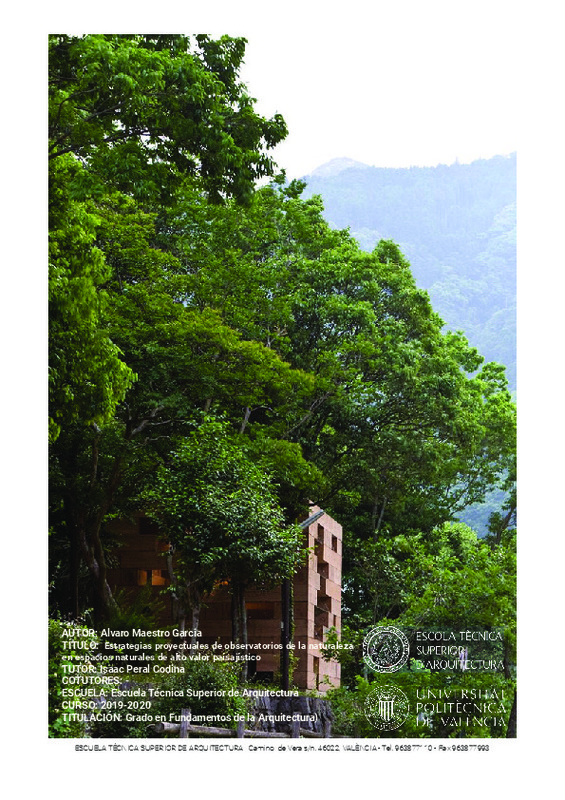JavaScript is disabled for your browser. Some features of this site may not work without it.
Buscar en RiuNet
Listar
Mi cuenta
Estadísticas
Ayuda RiuNet
Admin. UPV
Estrategias proyectuales de observatorios de la naturaleza en espacios naturales de alto valor paisajístico
Mostrar el registro sencillo del ítem
Ficheros en el ítem
| dc.contributor.advisor | Peral Codina, Isaac
|
es_ES |
| dc.contributor.author | Maestro García, Álvaro Miguel
|
es_ES |
| dc.date.accessioned | 2020-01-10T10:16:40Z | |
| dc.date.available | 2020-01-10T10:16:40Z | |
| dc.date.created | 2019-10-24 | es_ES |
| dc.date.issued | 2020-01-10 | es_ES |
| dc.identifier.uri | http://hdl.handle.net/10251/134192 | |
| dc.description.abstract | [ES] Actualmente, nuestra cultura medioambiental, da por hecho que los espacios naturales deben conservarse como condición indispensable para garantizar la sostenibilidad de nuestro planeta a largo plazo. Por esta razón es evidente que en principio no parece pertinente utilizar los espacios naturales de gran valor como lugar para la arquitectura. Sin embargo, a veces es necesario por razones funcionales imprescindibles y otras porque sirven para reforzar o complementar el valor del lugar ayudando a su conservación, aumentando la valoración y expectativas que, tanto la población local como los visitantes, tienen sobre dicho espacio natural objeto de la intervención. Este último caso, donde el paisaje natural tiene atención de paisaje cultural, es el objeto del presente trabajo. A través del análisis de diversos casos de estudio de arquitecturas y sus modos de relación con la naturaleza, se obtendrán los mecanismos y estrategias de inserción paisajística de dichos elementos arquitectónicos y de cómo una arquitectura de calidad puede enriquecer un paisaje para implementarle la condición de lugar. A demás el presente estudio tratará de aplicar las conclusiones a un diseño real, proyectando una torre de observación en La reserva de humedales Al Wathba en Abu Dhabi, en el este de la isla de Abu Dhabi, en salinas conocidas como sabkhas y dunas de arena fosilizadas, donde actualmente se pretende construir. | es_ES |
| dc.description.abstract | [EN] 1422/5000 Currently, our environmental culture assumes that natural spaces must be conserved as an indispensable condition to guarantee the sustainability of our planet in the long term. For this reason it is evident that in principle it does not seem appropriate to use natural spaces of great value as a place for architecture. However, sometimes it is necessary for essential functional reasons and others because they serve to reinforce or complement the value of the place by helping to conserve it, increasing the value and expectations that both the local population and visitors have over said natural space. the intervention. This last case, where the natural landscape takes care of cultural landscape, is the object of the present work. Through the analysis of several cases of study of architectures and their ways of relating to nature, we will obtain the mechanisms and strategies of landscape insertion of these architectural elements and how a quality architecture can enrich a landscape to implement the condition of place . In addition, the present study will try to apply the conclusions to a real design, projecting an observation tower in the Al Wathba wetland reserve in Abu Dhabi, in the east of the island of Abu Dhabi, in salt flats known as sabkhas and sand dunes fossilized, where it is currently intended to build | en_EN |
| dc.language | Inglés | es_ES |
| dc.publisher | Universitat Politècnica de València | es_ES |
| dc.rights | Reconocimiento - No comercial (by-nc) | es_ES |
| dc.subject | Estrategias de integración | es_ES |
| dc.subject | Desintegración | es_ES |
| dc.subject | Estrategias proyectuales | es_ES |
| dc.subject | Paisaje natural | es_ES |
| dc.subject | Lugar | es_ES |
| dc.subject | No-lugar | es_ES |
| dc.subject | Paisaje cultural | es_ES |
| dc.subject | Identidad social | es_ES |
| dc.subject | Dialéctica: naturaleza ¿ arquitectura | es_ES |
| dc.subject | Conciencia ambiental. | es_ES |
| dc.subject | Integration strategies | en_EN |
| dc.subject | Disintegration | en_EN |
| dc.subject | Project strategies | en_EN |
| dc.subject | Natural landscape | en_EN |
| dc.subject | Place | en_EN |
| dc.subject | No-place | en_EN |
| dc.subject | Cultural landscape | en_EN |
| dc.subject | Social identity | en_EN |
| dc.subject | Dialectic: nature - architecture | en_EN |
| dc.subject | Environmental awareness. | en_EN |
| dc.subject.classification | PROYECTOS ARQUITECTONICOS | es_ES |
| dc.subject.other | Grado en Fundamentos de la Arquitectura-Grau en Fonaments de l'Arquitectura | es_ES |
| dc.title | Estrategias proyectuales de observatorios de la naturaleza en espacios naturales de alto valor paisajístico | es_ES |
| dc.type | Proyecto/Trabajo fin de carrera/grado | es_ES |
| dc.rights.accessRights | Abierto | es_ES |
| dc.description.bibliographicCitation | Maestro García, ÁM. (2019). Estrategias proyectuales de observatorios de la naturaleza en espacios naturales de alto valor paisajístico. http://hdl.handle.net/10251/134192 | es_ES |
| dc.description.accrualMethod | TFGM | es_ES |
| dc.relation.pasarela | TFGM\103954 | es_ES |
Este ítem aparece en la(s) siguiente(s) colección(ones)
-
ETSA - Trabajos académicos [4687]
Escuela Técnica Superior de Arquitectura






